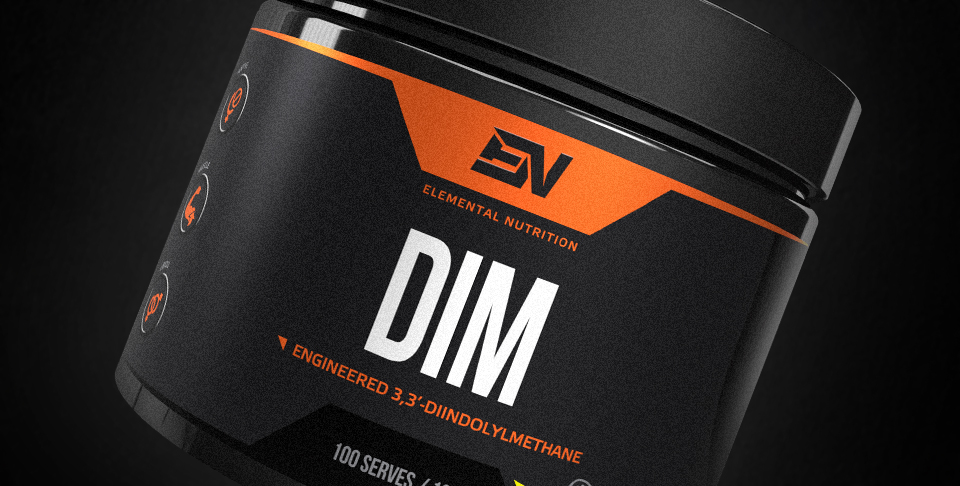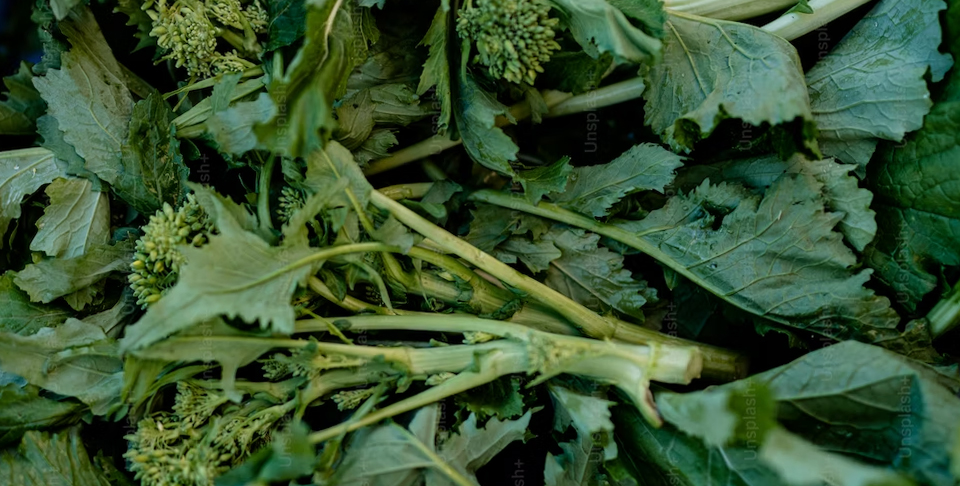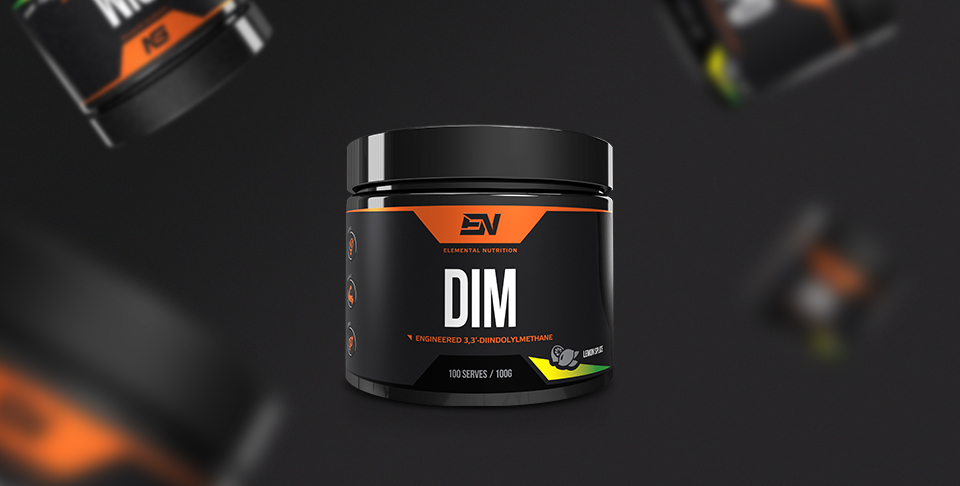Quick Summary Points & Introduction
- Diindolylmethane (DIM) is a compound found in cruciferous vegetables such as broccoli & brussels sprouts.
- DIM supplements may support healthy estrogen metabolism, potentially maintaining a favourable balance of estrogen metabolites.
- Some research suggests that DIM may help reduce the risk of hormone-driven cancers, though further investigation is needed.
- DIM might support athletic performance by potentially influencing estrogen levels, thereby possibly assisting muscle building & fat loss.
- The generally recommended daily dose of DIM ranges from 150-200mg. High doses of DIM, exceeding 300mg per day, might cause mild side effects like digestive issues & headaches in some individuals.
- More research is needed to confirm the safety of DIM in pregnant women, nursing mothers, & children.
- DIM may potentially support healthy testosterone levels, particularly in older men, by inhibiting the conversion of testosterone into estrogen.
- DIM supplements are typically available in powder & capsule form, they may be found as a stand-alone supplement or as part of testosterone-boosting formulas.
- Combining DIM with other hormone-influencing products or bodybuilding supplements could potentially enhance its effects.
- While preliminary studies suggest possible health benefits of DIM, it's important to remember that more research is needed.
Diindolylmethane, often abbreviated as DIM, is a compound that has attracted the interest of both the scientific & athletic communities due to its potential to influence hormone levels, specifically estrogen metabolism. Found naturally in cruciferous vegetables, DIM is also available as a dietary supplement, which may offer several potential benefits, from supporting athletic performance to promoting a healthier balance of estrogen metabolites.
While there's promising preliminary research, further investigation is needed to confirm these potential benefits & determine safe & effective dosage guidelines. This article dives deeper into what DIM is, where it comes from, its potential health benefits, & its use in athletic performance.
What is Diindolylmethane?
Diindolylmethane, often shortened to DIM, is a dietary indole found in cruciferous vegetables. The compound's structure consists of two indole groups attached to a methane group. Research suggests that DIM may influence the activity of enzymes involved in estrogen metabolism, potentially promoting a healthy balance of estrogen metabolites in the body.
Where Does Diindolylmethane Come From?
Diindolylmethane is naturally occurring in cruciferous vegetables, particularly those in the Brassica family such as broccoli, brussels sprouts, kale, & cabbage. It can also be found in cauliflower, radishes, watercress, & turnips.
Diindolylmethane Health Benefits
The key potential health benefits of DIM are listed below:
- Hormone Regulation: DIM may influence estrogen metabolism, potentially promoting a healthier balance of estrogen metabolites in the body. This could help reduce the risk of hormone-dependent conditions and mitigate symptoms of premenstrual syndrome (PMS).
- Cancer Research: Preliminary laboratory and animal studies suggest that DIM might have anti-cancer properties. It's important to note that this does not equate to DIM being a proven cancer treatment or preventative measure in humans.
- Anti-Inflammatory Properties: Some studies suggest DIM might have anti-inflammatory effects, which could be beneficial for conditions like arthritis, asthma, or inflammatory bowel disease.
- Immune System Support: Early research indicates that DIM might help the immune system function more effectively, though the mechanism isn't fully understood yet.
- Potential Skin Health Benefits: Some evidence suggests that DIM might assist with certain skin conditions, such as acne, due to its potential effects on hormone regulation.
Whilst the above-listed potential health benefits are exciting. We highlight that further scientific studies are required to confirm them. As such no claims are made that DIM is a prevention or cure for these medical conditions.

Diindolylmethane Benefits for Athletes
The key potential athletic benefits of DIM are listed below:
- Estrogen Balance: By potentially influencing the balance of estrogen metabolites, DIM might indirectly support muscle building & fat loss, an effect of interest to athletes, especially bodybuilders.
- Free Testosterone Support: DIM may inhibit the conversion of testosterone into estrogen, potentially promoting higher levels of free testosterone in the body. Free testosterone can support muscle growth & performance.
- Potential Fat Loss: By potentially reducing the estrogenic effects that can contribute to fat gain, DIM might support athletes' goals related to body composition & fat loss.
- Improved Recovery: By potentially influencing inflammation & hormone balance, DIM could potentially aid in recovery after intense workouts.
All potential Athlete benefits as with health benefits do require further scientific studies to confirm them.
Diindolylmethane Recommended Doses and Ingredient Timing
The recommended dose for DIM tends to range between 150 – 200mg per day. However, as with any supplement, it's always best to refer to the manufacturer's label directions or consult with a professional to determine the most appropriate dosage for your individual needs & conditions.
Diindolylmethane Side Effects, Safety and Negatives
While short-term administration of DIM is generally considered safe for most adults, doses higher than 300mg per day may cause mild side effects like digestive issues or headaches in some individuals. Moreover, DIM side effects are generally mild & only last for a short period of time.
Although appearing safe, there isn't enough research to confirm the safety of DIM use in pregnant women, nursing mothers, & children.
Diindolylmethane and Testosterone
There's some evidence to suggest that DIM could have a positive impact on testosterone levels, especially in older men. However, it's important to note that this doesn't mean DIM is a cure for low testosterone levels or related health issues. More research is needed to confirm and better understand this potential benefit.
Diindolylmethane Supplements
Diindolylmethane is available in Australia from Mr Supplement. You can find it in a stand-alone supplement such as Elemental Nutrition DIM or included in some testosterone-boosting formulas.
Stacking Diindolylmethane
DIM can be combined with other hormone-modulating products or bodybuilding supplements, such as Tribulus Terrestris, Long Jack, or Protein Powders. As always, it's best to consult with a healthcare professional before starting any new supplement regimen.
Conclusion
Diindolylmethane (DIM) is a fascinating compound that offers potential health & athletic performance benefits, thanks to its possible influence on estrogen metabolism. Naturally found in cruciferous vegetables, it can also be conveniently consumed as a dietary supplement. The benefits of DIM are numerous, ranging from potential anti-cancer properties, & the possible mitigation of inflammation, to potentially assisting in hormone balance for improved athletic performance.
However, as promising as these benefits are, it's essential to note that more research is needed to further explore these possibilities & establish definitive dosage guidelines & safety profiles. As always, it's crucial to consult with healthcare professionals before integrating new supplements like DIM into your routine. As our understanding of DIM expands, it's exciting to consider the new insights & applications that future research may reveal.
References
- Bradlow, HL, Telang NT, Sepkovic DW, Osborne MP, 2-hydroxy-estrone: the ‘good’ estrogen, J Endocrinol. 1996 Sep; 150 Supple: 5259-65.
- Chen, I, McDougal A, Wang F, Safe S; Aryl hydrocarbon receptor-mediated anti-estrogenic and anti-tumorigenic activity of diindolylmethane (DIM). Carcinogenesis 1998 Sep; 19(9): 1631-9.
- Krieg M, Nass R, and Tunn S, Effect of aging on endogenous level of 5 alpha-dihydrotestosterone, testosterone, estradiol, and estrone in epithelium and stroma of normal and hyperplastic human prostate. J Clin Endocrine Metab 1993 Aug; 77(2): 375-81.
- Bradlow, H. L., Telang, N. T., Sepkovic, D. W., & Osborne, M. P. (1991). 2-hydroxyestrone: the 'good' estrogen. The Journal of endocrinology, 150 Suppl, S259–S265.
- Kong, D., Li, Y., Wang, Z., Sarkar, F. H. (2007). Cancer Stem Cells and Epithelial-to-Mesenchymal Transition (EMT)-Phenotypic Cells: Are They Cousins or Twins?. Cancers, 3(1), 716–729.
- Rajoria, S., Suriano, R., Parmar, P. S., Wilson, Y. L., Megwalu, U., Moscatello, A., Bradlow, H. L., Sepkovic, D. W., Geliebter, J., Schantz, S. P., Tiwari, R. K. (2011). 3,3'-diindolylmethane modulates estrogen metabolism in patients with thyroid proliferative disease: a pilot study. Thyroid : official journal of the American Thyroid Association, 21(3), 299–304.
- Thomson, C. A., Ho, E., & Strom, M. B. (2016). Chemopreventive properties of 3,3'-diindolylmethane in breast cancer: evidence from experimental and human studies. Nutrition reviews, 74(7), 432–443.
- Maruthanila, V. L., Poornima, J., Mirunalini, S. (2014). Attenuation of Carcinogenesis and the Mechanism Underlying by the Influence of Indole-3-carbinol and Its Metabolite 3,3'-Diindolylmethane: A Therapeutic Marvel. Advances in pharmacological sciences, 2014, 832161.
- Leong, H., Riby, J. E., Firestone, G. L., & Bjeldanes, L. F. (2004). Potent ligand-independent estrogen receptor activation by 3,3'-diindolylmethane is mediated by cross talk between the protein kinase A and mitogen-activated protein kinase signaling pathways. Molecular endocrinology (Baltimore, Md.), 18(2), 291–302.
- Ahmad, A., Kong, D., Wang, Z., Sarkar, S. H., Banerjee, S., & Sarkar, F. H. (2011). Down-regulation of uPA and uPAR by 3,3'-diindolylmethane contributes to the inhibition of cell growth and migration of breast cancer cells. Journal of cellular biochemistry, 112(11), 3281–3292.
- Beaver, L. M., Yu, T. W., Sokolowski, E. I., Williams, D. E., Dashwood, R. H., & Ho, E. (2012). 3,3'-Diindolylmethane, but not indole-3-carbinol, inhibits histone deacetylase activity in prostate cancer cells. Toxicology and applied pharmacology, 263(3), 345–351.



